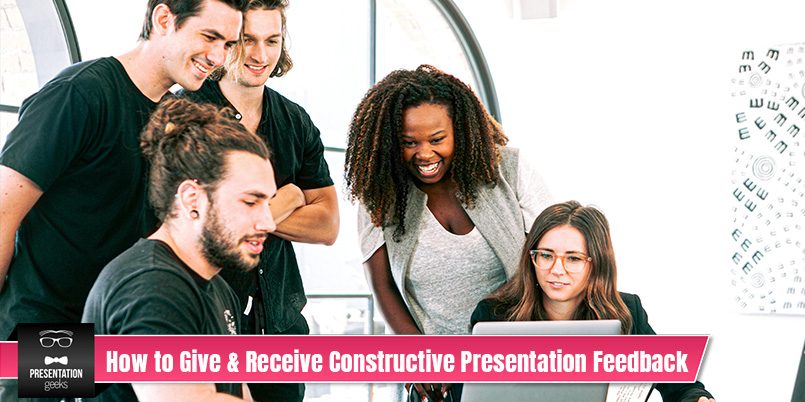How To Give Constructive Presentation Feedback

People are always looking for feedback yet not enough people give honest, good, constructive feedback. The feedback received is rarely helpful.
Giving constructive presentation feedback is an art you should master. By being able to not only receive constructive criticism, but give it as well, you’ll get a better appreciation for other people’s presentation skills and reflect upon yours. It will make navigating your own feedback journey easier.
Below you’ll find ways on how to give constructive feedback next time you’re asked.
Focus On Behaviour, Not The Person
When giving feedback, make sure it’s on the skills a person can control and change such as their behaviour rather than themselves as a person.
When you give feedback which targets a person’s character rather than their behaviour, they’ll become defensive and the feedback comes across as harsh criticism rather than constructive feedback.
Be Actionable
When giving feedback, follow up with an actionable item the person can do to work towards improving.
For example, if you felt their presentation didn’t flow well and you were lost as an audience member, don’t just leave it at that. Expand upon your comment by suggesting they add a slide outlining key agenda items. Take it a step further and explain why you suggested this.
You may say, ” I would suggest adding a slide which outlines key objectives because it will give the audience clear takeaways as to what to expect throughout the presentation. This is something I felt was missing.”
This is an actionable item someone can take away and implement and you’ve backed it up with a strong reason as to why they should do it.
Be Specific
Make sure the feedback you’re providing is specific.
Don’t just say someone needs to improve their communication skills. Be specific!
You could frame the feedback in a way that targets different forms of communication. You could pinpoint to their body language or their oral presentation. Both are forms of communication skills and without being specific, they wouldn’t know what to improve upon.
Be Realistic
Learning and growing is an ongoing progression. We can’t go from 0 – 100 overnight. We need to set realistic boundaries with the feedback we provide.
You want to be realistic when you communicate key points someone can improve on to ensure they don’t get discouraged and quit.
Be Timely
If requested to give feedback, be sure to do it in a timely manner.
Providing feedback in a timely manner will not only benefit the one asking, but you as well as you’re able to provide more accurate feedback.
As time goes on, you’ll begin to forget the small details that made up the entire presentation. By giving feedback in a timely manner, you’ll be able to provide more accurate and effective feedback.
Offer Continuing Support
Continuing support will take your ability to provide feedback to the next level and is immensely helpful.
Offer continuing support will allow you to establish a long-lasting rapport with people. These same people will most likely be providing you with feedback in the future.
Giving ongoing support will also allow you to become a master of your craft. The best way of fully understanding a topic is by teaching it. To become a master of presenting, you also need to be open to giving feedback. It will help you remain consistent.
End On A Positive Note
Lastly, end all feedback on a positive note.
The best growth and learning stems from positive reinforcement which can be as simple as ending things off with a positive note. Be mindful and honest with what positive note you want to end on.
A sincere compliment is far more effective than one that feels forced.
Looking For Powerpoint Design Agency?
Call Pursho @ 0731-6725516
Telegram Group One Must Follow :
For Startups: https://t.me/daily_business_reads
#Effective #Presentation #Feedback #Improve #Impact






